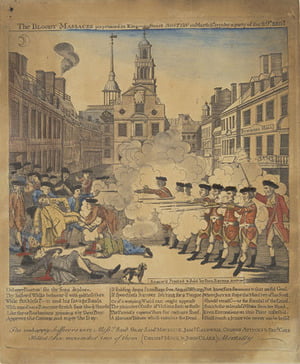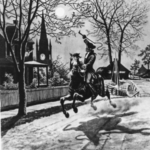Where would America be today if it never fought for independence? Would the American dream exist? The most significant events that led to the American Revolution include: the obligatory taxes that were made payable to Great Britain, the various security values that were infringed by the English soldiers during the Boston Massacre, and finally, the nationalistic pride they gained after the seven year war. The colonies debated England’s legal power to tax them and did not wish to be taxed without representation. The colonists felt that they had achieved a high level of patriotism after completing the seven year war.
In 1764, British Prime Minister George Greenville passed the Sugar Act and Currency Act which created economic adversity in the colonies. Protests and boycotts quickly emerged, due to the high costs on British goods. One year later, on March 22, 1765, the British parliament initiated a new law called the Stamp Act. The Stamp Act made colonists responsible for paying taxes on any legal document; paper, newspapers, ships papers, playing cards. According to Thomas Paine in Common Sense, “we may be as effectually enslaved by the want of laws in America, as by submitting to the laws made for us in England” (PAINE 59); he argued that taking up England’s laws was their (colonists) downfall in creating progress as a country.
Boston was a very perturbed town during the 1760s. British troops were assigned to prevent hostilities and corruption. That uneasiness quickly turned into bitterness at the beginning of the 1770s. On March 5, 1770 a small group of colonists were up to their usual sport of tormenting British soldiers. This taunting eventually led to conflict. The group eventually grew with more colonists. One of them felt the need to ring the church bell which signified that a fire was going on. The guards called for help and more British Soldiers came to the rescue. Calming the crowd down was pointless. Apparently, a soldier fired a musket into the crowd, immediately followed by more shots. This action left several wounded and five dead including an African-American named Crispus Attucks. This whole incident came to be known as the Boston Massacre. It was a huge turning point in the American Revolution because it gave the Americans a reason to fight though it was a possible misunderstanding. Thomas Paine advocated that the Church of England had violated many safety morals in the sense that, “every quiet method for peace hath been ineffectual. Our prayers have been rejected by disdain.” (PAINE 57) Paine felt that they were heading in the wrong direction under the control of Great Britain. While Great Britain was benefiting from the cause, colonists were bearing the dirty work that lay upon them.
Apart from the Sugar Acts, came the Intolerable Acts, which gave Colonists even more reason to start a revolution. The Intolerable Acts were 4 laws that threatened the liberty of all the colonies. They were passed by British Parliament in 1774, with the motive to take more control over the American Colonies. One of the noteworthy laws that angered the colonists was known as the Boston Port Act which required the Boston Port to close down until the colonists paid back Britain for the tea they threw over the ship. In the Declaration of Independence it was clearly stated that Colonists were angered, “For (parliament) cutting off our trade with all parts of the world.” (D.o.I) The Quartering Act was also significant because it gave British troops the right to force Colonists to take care of them in their homes whether they liked it or not. The Intolerable Acts took away all the Colonist’s rights and limited their freedom.
After the Seven Years War (1753-1763) the Colonists had gained a lot of pride and want for independence. The colonists had a developed an American identity which was seen during the war. The British soldiers wore red apparel while the Colonists wore their everyday apparel. The share of English culture started to decline in the 1700s. Time had taken its toll and you had a large difference between the Colonist and British customs. After the war, the Stamp act was quickly brought about the colonies. The Stamp Act stated that, “several duties were granted, continued, and appropriated, towards defraying the expenses of defending, protecting, and securing, the British colonies and plantations in America.” (The Stamp Act, 1765) The colonists weren’t delighted at all with the taxes they had to pay. Since the Americans did not believe they were being represented in government, they opposed the Stamp Act. Colonists went as far as looting tax collectors houses. They protested peacefully and violently until the act was finally repealed. One year later, the first Continental Congress had assembled in Carpenter’s Hall in Philadelphia on September 5, 1774 to consider addressing the ill treatment – mainly the heavy taxes – of the 13 colonies by England. (OFM 170) The Colonists had an economic crisis and they knew that paying taxes would never help their cause. The second Continental Congress was held on June 7, 1776. (OFM 133) It established the militia as the Continental Army to represent the thirteen colonies. They also elected George Washington as Commander in Chief of the Continental Army. All these events were significant because they it was inspired by the sense of self-respect and gratification gained from the Seven Years War.
The main turning points that had much influences on the American Revolution include, the hard taxation laws that the colonists had to follow, the Boston Massacre, and the new culture that was realized and took a stance after the Seven Years War. Diversity existed not only in the population but also in background. The American Revolution was very important to society because it combined cultures from around the world into one and even today it keeps on growing.
Bibliography
Paine, Thomas. “Document 12.” Common Sense. New York, 1776.
Faragher. “Continental Congress.” Out of Many. 2005
Zaagsma, Gerben. “The Stamp Act and the Sugar Act.” March, 2003.



